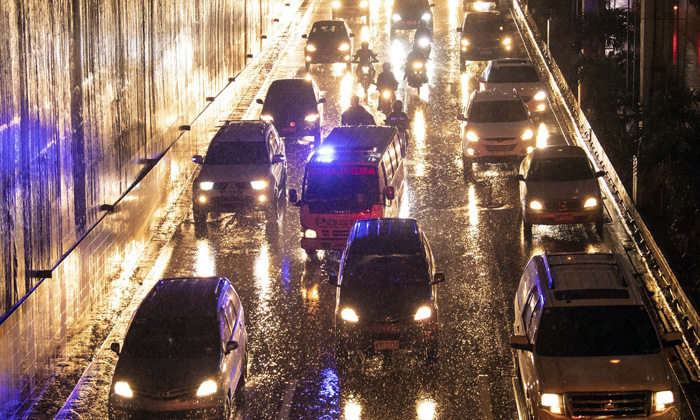ONLY IN THE PHILIPPINES: Patients die as ambulances get stuck in traffic jam
HANG IN THERE. The photo, taken on Aug. 5, shows an ambulance negotiating through rush hour-traffic along EDSA in Metro Manila where traffic logjams have been a daily nightmare. No official figures are immediately available but the delays, causing an unnecessary limp in the race to the hospitals, has cost, according to paramedics, the loss of some lives. AFP
.
ADS by Cloud 9:
.
– SPACE RESERVE FOR YOUR ADVERTISEMENT –

.
– SPACE RESERVE FOR YOUR ADVERTISEMENT –

Life or deathNeither the government nor ambulance companies keep count of how many patients die in traffic each year, officials said, but emergency medical workers in the city have many horror stories.Laylo says one patient died inside his ambulance after heavy traffic on a narrow road added 10 minutes to the journey from the patient’s home to the hospital.“It was about 5.7 kilometers. Normally it would take us less than five minutes, but it took us 15 minutes that time,” Laylo explained.ADS by Cloud 9:
.
– SPACE RESERVE FOR YOUR ADVERTISEMENT –

“When you’re trying to save a person’s life, that is very slow,” he said, still upset by the 2017 incident.Images of ambulances stalled in unmoving traffic jams have sparked outrage on social media in the Philippines.One of the most notorious examples—which has been viewed over 3.2 million times online—was filmed by a woman shocked that cars wouldn’t or couldn’t give way to the ambulance carrying her mother.
ADS by Cloud 9:
.
– SPACE RESERVE FOR YOUR ADVERTISEMENT –

“I was very angry. I was worried too because we couldn’t do anything about the vehicles blocking our lane,” the woman, Jing Zamora, told AFP.The trip took hours when it should have taken minutes. Zamora’s mother, who suffered a stroke, survived the trip to the hospital but died there a week later.A swift medical response is key to recovery, according to the American Stroke Association.Officials like Aldo Mayor, public safety chief of the Metro Manila Development Authority, put at least part of the blame on other road users.“Some people simply do not care. It is as if they are the only residents of this world,” said Mayor, whose government agency manages the capital’s chaotic traffic.
ADS by Cloud 9:
.
– SPACE RESERVE FOR YOUR ADVERTISEMENT –

.
– SPACE RESERVE FOR YOUR ADVERTISEMENT –

‘Ambulances cannot levitate’These problems come as Manila’s population has roughly doubled since 1985 and its infrastructure has not kept up.Its limited system of commuter rail is augmented by jeepney mini-buses and millions of cars.The nation’s thicket of bureaucracy and deep-rooted corruption have stalled or blocked efforts to build new roads, bridges and public transit.President Rodrigo Duterte pledged to unblock the capital’s choking gridlock, but halfway through his term the city’s main thoroughfare, EDSA, remains a parking lot at rush hour.The sheer number of cars on the roads is a major factor in whether ambulances can get their patients to hospital quickly, said Vernon Sarne, a long-time automotive journalist.ADS by Cloud 9:
.
– SPACE RESERVE FOR YOUR ADVERTISEMENT –

“Even when you want to give way, but the motorway is full, what can we do? The ambulance cannot levitate,” he told AFP.However, Sarne noted that drivers have become cynical, thinking ambulances might be using their lights and sirens just to cut through the traffic for non-emergencies.“As a motoring public we are jaded to the fact that everyone is taking advantage of us,” he said, adding some politicians use emergency vehicles escorts to avoid the gridlock.Yet ambulance operators in Manila hope public shaming on social media, like Zamora’s viral video, can help.

ADS by Cloud 9:
.
– SPACE RESERVE FOR YOUR ADVERTISEMENT –

ADS by Cloud 9:
.
– SPACE RESERVE FOR YOUR ADVERTISEMENT –


All photographs, news, editorials, opinions, information, data, others have been taken from the Internet..aseanews.net









